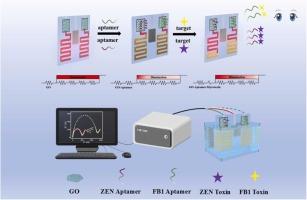一种同时检测两种真菌毒素的便携式视觉/电化学双模式生物传感平台
IF 11.3
1区 环境科学与生态学
Q1 ENGINEERING, ENVIRONMENTAL
引用次数: 0
摘要
真菌毒素构成严重的健康风险,并在全球范围内污染食品,但传统的检测方法在成本和复杂性方面存在局限性。为了解决这一问题,开发了便携式视觉/电化学双模生物传感平台。该平台集成了距离读出策略和空间分辨阵列电极,可以同时检测玉米赤霉烯酮(ZEN)和伏马菌素B1 (FB1)。适配体对ZEN和FB1的识别会引发阻抗和电压的变化,进而影响电化学发光(ECL)的长度。两种真菌毒素的浓度可以很容易地通过测量长度得到。同时,电化学阻抗谱(EIS)可以准确定量检测区域的阻抗变化,具有较宽的线性范围和较低的检测限。该平台结合了方便的视觉检测和高灵敏度的电化学检测,线性范围好(视觉模式,0.1 ~ 300 ng·mL-1;电化学模式,0.001 ~ 300 ng·mL-1)和低检出限(视觉模式,0.069和0.084 ng·mL-1;电化学模式,0.37和0.42 pg·mL-1)。通过将视觉生物传感器的便携性与电化学分析的精确性相结合,这项工作为多重霉菌毒素检测提供了现场可部署的解决方案,解决了食品安全方面的关键需求。本文章由计算机程序翻译,如有差异,请以英文原文为准。

A portable visual/electrochemical dual-mode biosensing platform for simultaneous detection of two mycotoxins
Mycotoxins pose severe health risks and contaminate food globally, but traditional detection methods face limitations in cost and complexity. To address this, a portable visual/electrochemical dual-mode biosensing platform was developed. This platform integrates a distance readout strategy and spatially resolved array electrodes, enabling the simultaneous detection of zearalenone (ZEN) and fumonisin B1 (FB1). The recognition of ZEN and FB1 by aptamers can trigger changes in impedance and voltage, which further affect the electrochemiluminescence (ECL) length. The concentrations of the two mycotoxins can be easily obtained by measuring the length. Meanwhile, the impedance change of the detection regions can be accurately quantified using electrochemical impedance spectroscopy (EIS), offering a broader linear range and a lower detection limitation than visual detection. This platform combines convenient visual detection and highly sensitive electrochemical detection with a good linear range (visual mode, 0.1 ~ 300 ng·mL-1; electrochemical mode, 0.001 ~ 300 ng·mL-1) and a low limit of detection (visual mode, 0.069 and 0.084 ng·mL-1; electrochemical mode, 0.37 and 0.42 pg·mL-1). By combining the portability of visual biosensors with the precision of electrochemical analysis, this work advances field-deployable solutions for multiplex mycotoxin detection, addressing critical needs in food safety.
求助全文
通过发布文献求助,成功后即可免费获取论文全文。
去求助
来源期刊

Journal of Hazardous Materials
工程技术-工程:环境
CiteScore
25.40
自引率
5.90%
发文量
3059
审稿时长
58 days
期刊介绍:
The Journal of Hazardous Materials serves as a global platform for promoting cutting-edge research in the field of Environmental Science and Engineering. Our publication features a wide range of articles, including full-length research papers, review articles, and perspectives, with the aim of enhancing our understanding of the dangers and risks associated with various materials concerning public health and the environment. It is important to note that the term "environmental contaminants" refers specifically to substances that pose hazardous effects through contamination, while excluding those that do not have such impacts on the environment or human health. Moreover, we emphasize the distinction between wastes and hazardous materials in order to provide further clarity on the scope of the journal. We have a keen interest in exploring specific compounds and microbial agents that have adverse effects on the environment.
 求助内容:
求助内容: 应助结果提醒方式:
应助结果提醒方式:


